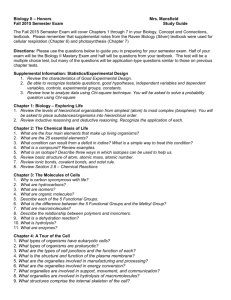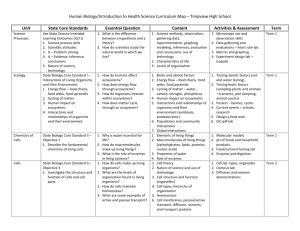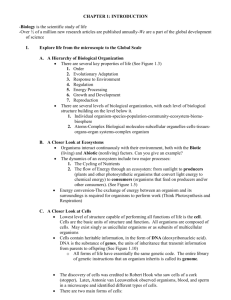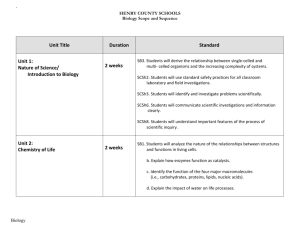Biology Syllabus
advertisement
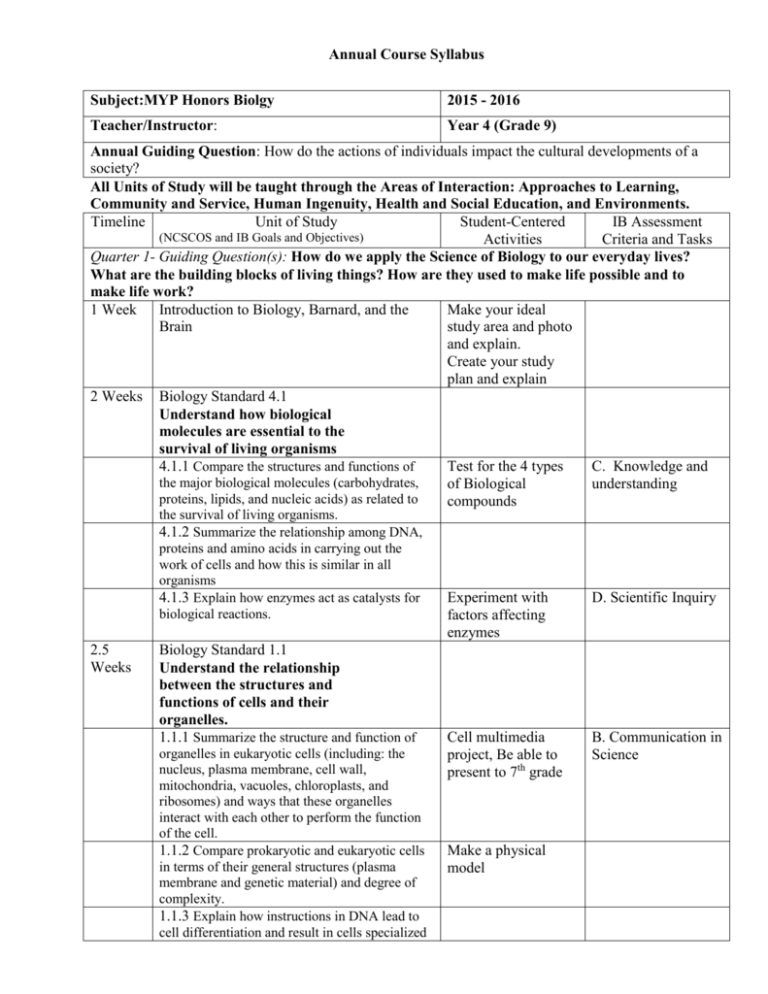
Annual Course Syllabus Subject:MYP Honors Biolgy 2015 - 2016 Teacher/Instructor: Year 4 (Grade 9) Annual Guiding Question: How do the actions of individuals impact the cultural developments of a society? All Units of Study will be taught through the Areas of Interaction: Approaches to Learning, Community and Service, Human Ingenuity, Health and Social Education, and Environments. Timeline Unit of Study Student-Centered IB Assessment (NCSCOS and IB Goals and Objectives) Activities Criteria and Tasks Quarter 1- Guiding Question(s): How do we apply the Science of Biology to our everyday lives? What are the building blocks of living things? How are they used to make life possible and to make life work? 1 Week Introduction to Biology, Barnard, and the Make your ideal Brain study area and photo and explain. Create your study plan and explain 2 Weeks Biology Standard 4.1 Understand how biological molecules are essential to the survival of living organisms 4.1.1 Compare the structures and functions of Test for the 4 types C. Knowledge and the major biological molecules (carbohydrates, of Biological understanding proteins, lipids, and nucleic acids) as related to compounds the survival of living organisms. 4.1.2 Summarize the relationship among DNA, proteins and amino acids in carrying out the work of cells and how this is similar in all organisms 4.1.3 Explain how enzymes act as catalysts for biological reactions. 2.5 Weeks Biology Standard 1.1 Understand the relationship between the structures and functions of cells and their organelles. 1.1.1 Summarize the structure and function of organelles in eukaryotic cells (including: the nucleus, plasma membrane, cell wall, mitochondria, vacuoles, chloroplasts, and ribosomes) and ways that these organelles interact with each other to perform the function of the cell. 1.1.2 Compare prokaryotic and eukaryotic cells in terms of their general structures (plasma membrane and genetic material) and degree of complexity. 1.1.3 Explain how instructions in DNA lead to cell differentiation and result in cells specialized Experiment with factors affecting enzymes D. Scientific Inquiry Cell multimedia project, Be able to present to 7th grade B. Communication in Science Make a physical model Annual Course Syllabus to perform specific functions in multicellular organisms. 2 Weeks Biology Standard 1.2 Analyze the cell as a living system. 2 Weeks Explain how homeostasis is maintained in the cell and within an organism in various environments (including: temperature and pH). Biology Standard 4.2 Osmosis and diffusion labs. B. Communication in Science Pigment experiment Yeast lab E. Processing Data Analyze the relationships between biochemical processes and energy use in the cell. 4.2.1 Analyze photosynthesis and cellular respiration in terms of how energy is stored, released, and transferred within and between these systems. 4.2.2 Explain ways that organisms use released energy for maintaining homeostasis (active transport). . Quarter 2- Guiding Question(s): How does the structure of a chemical aid in its function? How does the structures of a cell aid in its function? 2 Weeks Biology Standard 3.1 Explain how traits are determined by the structure and function of DNA. 3.1.1 Explain the double-stranded, Make models and complementary nature of DNA as related to its bulletin boards of function in the cell. protein synthesis 3.1.2 Explain how DNA and RNA code for proteins and determine traits. 3.1.3 Explain how mutations in DNA that result from interactions with the environment (i.e. radiation and chemicals) or new combinations in existing genes lead to changes in function and phenotype. 2 Weeks Biology Standard 1.2.2 Clay modeling Analyze how cells grow and reproduce in terms of interphase, mitosis and cytokinesis. 1.2.3 Explain how specific cell adaptations help cells survive in particular environments (focus on unicellular organisms). 1 Week Review and Benchmark Test 3 Weeks Biology Standard 3.2 Understand how the environment, and/or the interaction of alleles, influences the expression of genetic traits. 3.2.1 Explain the role of meiosis in sexual reproduction and genetic variation. C. Knowledge and Understanding Karyotype lab Annual Course Syllabus 3.2.2 Predict offspring ratios based on a variety of inheritance patterns (including: dominance, co-dominance, incomplete dominance, multiple alleles, and sex-linked traits). 3.2.3 Explain how the environment can influence the expression of genetic traits Punnet squares “coin flip” genetics Quarter 3- Guiding Question(s):How do organisms change over time? How do we group organisms? What does this tell us about the past? 2 Weeks Biology Standard 3.3 Understand the application of DNA technology. 3.3.1 Interpret how DNA is used for comparison Electrophoresis lab E. Processing Data and identification of organisms. 3.3.2 Summarize how transgenic organisms are engineered to benefit society. 3.3.3 Evaluate some of the ethical issues surrounding the use of DNA technology (including: cloning, genetically modified organisms, stem cell research, and Human Genome Project). 2 Weeks Online Debate C. Knowledge and Understanding B. Communication Biology Standard 3.4 Explain the theory of evolution by natural selection as a mechanism for how species change over time. 3.4.1 Explain how fossil, biochemical, and anatomical evidence support the theory of evolution. 3.4.2 Explain how natural selection influences the changes in species over time. 3.4.3 Explain how various disease agents (bacteria, viruses, chemicals) can influence natural selection. 1 Week Review and Benchmark # 2 2 Weeks Biology Standard 3.5 Analyze how classification systems are developed based upon speciation. 3.5.1 Explain the historical development and changing nature of classification systems. 3.5.2 Analyze the classification of organisms according to their evolutionary relationships (including: dichotomous keys and phylogenetic trees). Sex and the single guppy online lab Mapping Death lab, Chestnut Blight Classify insects Dissection A. One World E. Processing Data Annual Course Syllabus Quarter 4- Guiding Question(s): How do we all work together? What did we learn? How do we affect the rest of the world? 2 weeks Biology Standard 2.1 Analyze the interdependence of living organisms within their environments. 2.1.1 Analyze the flow of energy and cycling of Create an Ecosystem matter (water, carbon, nitrogen and oxygen) through ecosystems relating the significance of each to maintaining the health and sustainability of an ecosystem. 2.1.2 Analyze the survival and reproductive success of organisms in terms of behavioral, structural, and reproductive adaptations. 2.1.3 Explain various ways organisms interact with each other (including predation, competition, parasitism, mutualism) and with their environments resulting in stability within ecosystems. 2.1.4 Explain why ecosystems can be relatively stable over hundreds or thousands of years, even though populations may fluctuate (emphasizing availability of food, availability of shelter, number of predators and disease). 3 Weeks Paramecium Predation Lab Biology Standard 2.2 Understand the impact of human activities on the environment (one generation affects the next). 2.2.1 Infer how human activities (including Global warming population growth, pollution, global warming, debate. burning of fossil fuels, habitat destruction and Fracking Debate. introduction of nonnative species) may impact the environment. 2.2.2 Explain how the use, protection and conservation of natural resources by humans impact the environment from one generation to the next. 2 weeks Review and Final Exam A summary document providing an overview of the implementation of each area of interaction over the whole subject, with reference to units of study and specific projects. Annual Course Syllabus




